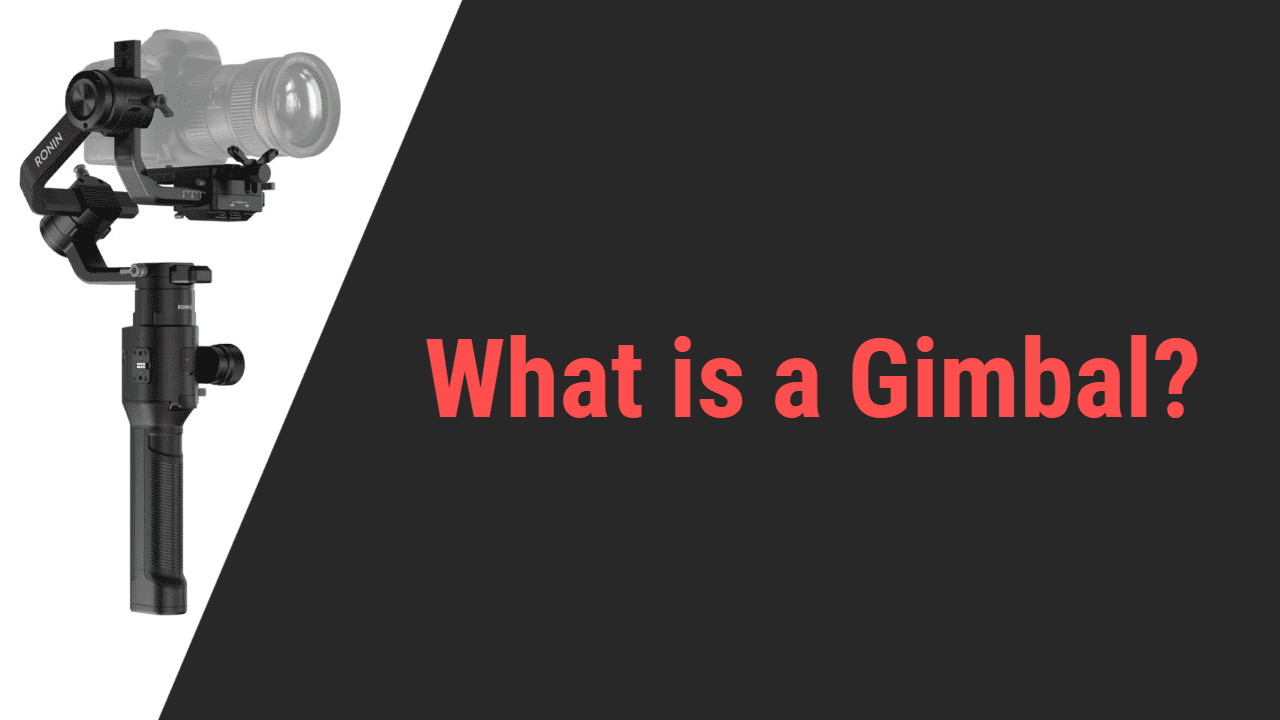Stability matters the most in the filmmaking world, whether you are shooting a regular picture or working as a TV or movie professional. And the base level of photography won’t do the trick of engaging that level of stability in the frame or keep your shots on point; that’s where everyone’s hands of the clock turn to the gimbal.
There is no way you haven’t heard about Gimbals if you are into photography, but if you haven’t, this is the right place for you; Because in the next few scrolls, you will get a deep insight into this smartest and most popular tool.
Once you go through the article, you will see how a gimbal can create a magical shot, and the operation is so levelheaded and smooth; It’s working, its purpose, and a little tip on how to advance the tool all things considerably followed up below.
Let’s dig in
Gimbal: Key to the professional cinema
In simple words, “Gimbals are the smart battery-operated tool that corrects the jitter or wobbles caused during filmmaking by compensating the camera shake.”
The gimbal allows the camera to stay put on top while the additional two or three-axis moves to catch creative angles in the frame.
They are one of the most convenient tools for carrying heavy cameras, one that intends nothing more than to enhance the image quality per se.
Evolution of Gimbal- Image stabilization is considered the most crucial factor in photography. This is because the stabilization works on reducing the blurred photos corrupted due to camera shake.
There are two ways to compensate for the camera shake effect in the picture, either from any software or the hardware OIS. This is the reason behind Gimbal’s innovative launch.
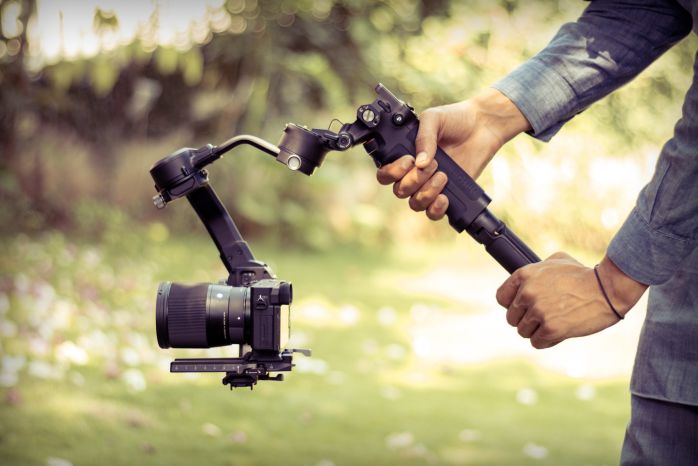
Earlier, videographers had a history with dollies, jigs, and Steadicam until the gimbal came on the board. As soon as they noticed the more comfortable way to shoot awkward angles and live action, The demand for Gimbals increased in the market.
The Technicality- The gimbals are an innovative pivoted support that allows the object(camera) to securely mount on top; While it permits the axis to rotate the object to catch different angles. The gimbal uses the intelligence configuration of sensors and a potent motor to detect the micro movement and stabilize the camera.
There are commonly two types of gimbals popular in the market two-axis and three-axis gimbals; These gimbals are named after the counteracting of all two or three motions (pan, tilt, and roll). ‘These three or two-axis gimbals work the whole stabilized part with their pan, tilt, or roll movement and provide the fluid and buttery smooth footage.
All of the gimbals are considerably compact tools assisted by the powerful computer algorithm that keeps the footage clean and balanced. These are the equipment that supports and procure silky-smooth video footage or still pictures while on the move. These tools are relatively budget friendly and do strain the wallet like any stabilizer or tracking shot tool.
Do I Need a Gimbal?
Now that’s a million-dollar question every individual asks before going all crazy about the working mechanism of the gimbal. The answer to that question is Yes; if you are a budding professional filmmaker who wants to bring changes in photography, the gimbals are an essential tool for your kit.
These gimbals are scientifically proven to spice things up and settle with extra interesting shots. But that’s not just it. Apart from the stability, gimbals are much more, and it can bring some pretty exciting changes in ordinary filming. So yeah, any keen photographer who wishes to live that joy of wonderful shots needs to buy the gimbal right away.
So, it’s proven there are many ways to get a smooth shot, so why do professionals always choose gimbals as their first priority; Let’s see why
- Gimbals are the ultimatum to jerky, unwanted bolt, and blurry shots.
- They are wise tools to add buttery flow smoothness in dynamic shooting.
- They are the lightest weight and travel-friendly to use on any adventure.
- The gimbals can slay live actions, sports, and high-level photography.
- Their usage saves time by cutting down the moment you take in switching angles and directions.
- They are easiest to install and begin with; In short, it is a professional tool without any professional guidance requirement.
- They let you brilliantly shoot aerial, underwater, tighter space, and challenging shots.
- The gimbals allow you to comfortably carry your heavy camera to shoot the longest hour.
- They allow the safest pairing of additional accessories and sub-tools.
- The gimbals take care of your camera and lens security by holding them firmly during the trickiest shot.
Types of Gimbals
With the intention to kick start creative portable photography, gimbals are approached as a stabilization system that is designed to grant the professional independence of shooting without a camera shake.
These smartest tools have the grand support of advanced internal configuration, which subjectifies their working. On the basis of the working mechanism and configuration, the gimbal is classified into two different types: Mechanical and Motorized Gimbal.
Motorized Gimbal – Motorized Gimbals are the most common gimbal used to this day. These motorized gimbals have incorporated three brushless motors, motors that help keep the camera level on axes during the camera movements. These gimbals fancy the IMU that sense micromovement and compensate the same in order to grant some flawless, smooth pictures. These are pretty neat, effective, comfortable, and well-known tools which cannot be said the same for mechanical gimbals.
Mechanical Gimbals- That was the whole motor competency; the mechanical gimbals are pretty basic gimbal models, which include the sled for work. These gimbals have a top stage for attaching the camera and the post that can be extended and batteries. The stabilizer stays upright and makes the bottom heavier than the top, only to pivot. With a certain center of gravity, the whole stabilization work in this gimbal
How does a Gimbal Work?
Famous for their versatile character, Gimbals are the simplest handheld tool that is dominantly used to reduce the shakiness of footage.
The gimbals are destined to enhance the image quality as they clear the footage with unwanted jolts and bumps, but how did it work? What magic or spell does the gimbal cast in picking up that buttery smooth flow in every dynamic shot? Let’s see how a gimbal works.
Elements– Certainly, the gimbal is all mighty with interesting work of stability; but clearly, the tool doesn’t work on its own. So, the significant part that plays a key role in the gimbal work mechanism is
- Sensors- The brain of the whole operation; The Inertial Measurement Unit
- Motor- The potent motor carrying out assigned task
- Gyroscope- Another crucial part that works for the camera rotation
- Accelerometer- Companying gyroscope for the acceleration
- Axis- The suitable number of axes for movement
- Handlebar- The bar to hold the gimbal for filming
Working Theory– Backed up by the potent algorithm and gyroscope sensor, the gimbal performs the functions using the “Detect, Hold and Move” Theory. The strategy subject to the gimbal requires the camera to be mounted on top with a firm grip.
When the camera is placed at the center, the axes move in a different way (Pitch, roll, and tilt) to take the shot without disturbing the camera. The finest conspiracy of motors and sensors does the job of detecting the movement and stabilizing them.
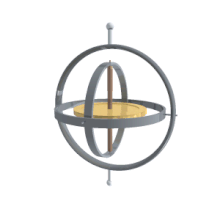
The process– All of the described parts come together to lead the way in stabilizing the footage. The Advance Inertial Measurement Unit (IMU) initiates the operation by detecting the micromovement caused during the shooting.
The gimbals are designed smartly enough to distinguish between intentional and unintentional movement. The accelerometer in the IMU is associated with detecting the slightest unintentional movement, while the gyroscope works on sensing the movement of the axis.
Once the IMU differentiates between the desired action and accidental movement, the main process starts. The intention movement by the photographer was passed on without any disturbance. And when the IMU detects the accidental shake or micromovement, it gives the motor immediate command to take the right action.
The enormously powered motor stepped in the front and compensated for the shake by interchanging the camera’s position.
Gimbal Pan, Roll, and Tilt movements working
When you get into the gimbal stabilizing stuff, you will get to hear the term pan, roll, and tilt, or pitch, roll, and yaw; let’s get you a quick peek over how the gimbal moves around to shoot.
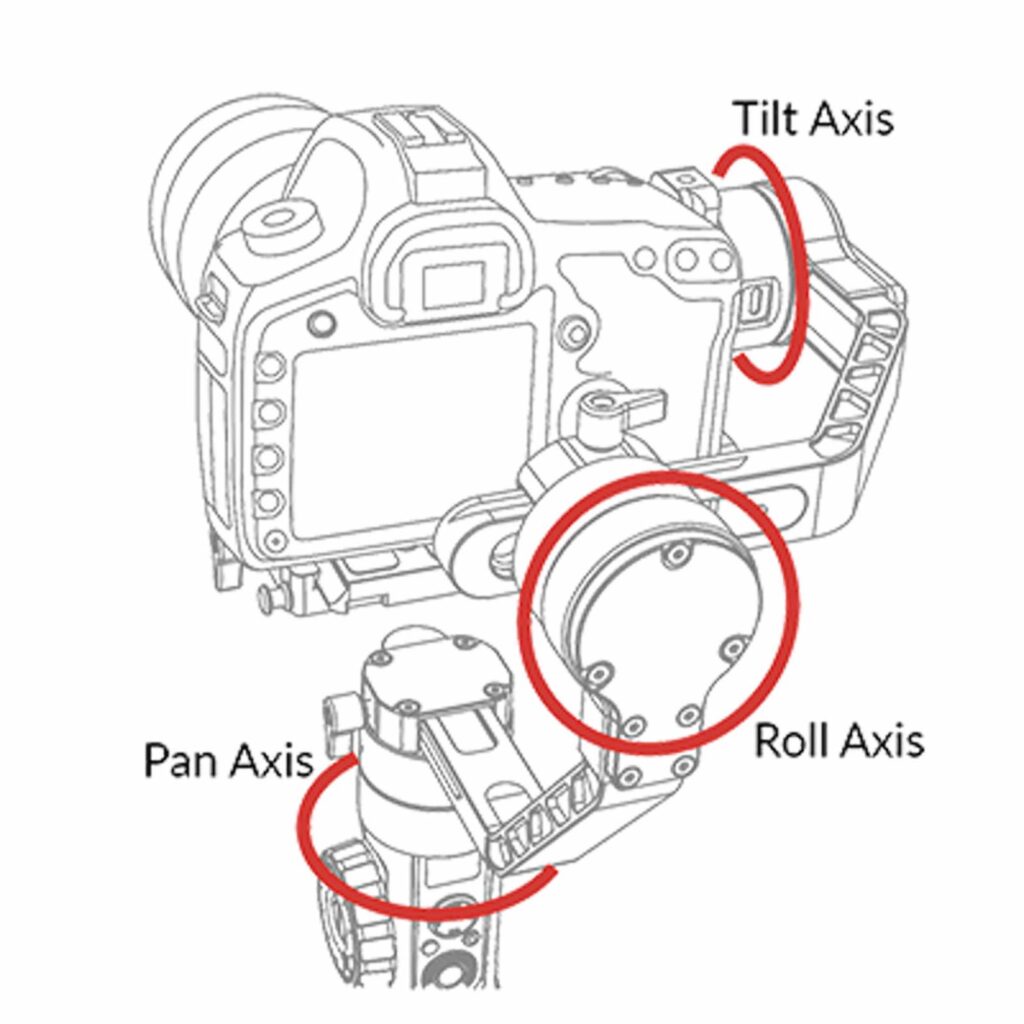
The primary obligations are to counteract the shakes and shudder in filmmaking every time you move your camera. These cameras on the gimbal can move around the pitch, roll, or yaw axes to give the ideal footage throughout the scene.
Let’s start with the pitch axis; this one is also called the tilt axis, and it allows the camera movement just up and down. When you choose this, you can capture the whole up-to-down footage, like the falling of an object.
Next is the yaw axis, which is also referred to as the pan axis; this allows the camera to capture the subject moving horizontally. In simple terms, the yaw or pan moving is the left-to-right camera movement.
And the last is Roll axes; this one is a little different from the others. The roll axis allows the camera to move at an unleveled angle to shoot a subject with the off-center vision of the trickiest angle.
2-axis and 3-axis Gimbal: Which one to choose?
The never-ending argument of decades, Two-axis gimbals or three-axis gimbals, which is better to strike filmmaking with, doesn’t actually employ the answer. This is because both of the gimbals are unique in their own way. They both have their own set of distinctive goods and bad on the basis of which one can choose their options.
Two-Axis Gimbals- The gimbals that work on stabilizing the picture using two axes are referred to as the two-axis gimbal. The primary character of these gimbals is to use the pitch and roll, or you can say tilt and roll movement, for capturing the still shots of videography.
The two-axis gimbals are an excellent choice for beginner photographers because they are the easiest to use and are found to be pretty cost-effectively. These two-axis gimbals are also the lightest weight and most compact compared to the three axes.
The two-axis gimbal also is greatest at power saving due to no involvement of a hectic motor; they come within the affordable price tag.
Three-Axis Gimbals- Those gimbals that use their three axes to move the camera during stabilizing procedure are labeled as three-axis gimbals. The three-axis gimbals are all creative with their three moves, pan, tilt, and roll, which is helpful in shooting stabilized footage.
There is no match for the professional-level stability offered by the three-axis gimbal, and nothing can beat the creativity the three-axis gimbal can grant. They might be a little heavy because of their motor involvement, but that very same motor injects the fastest, most accurate, and most responsive stabilizing.
Three-axis gimbals are known for their extra versatility character and reliably known for their high-tech innovation like the creative shooting modes and stuff.
How to use a gimbal like a pro?
What good could a gimbal bring if you don’t know how to use the tool correctly? Or what is the worth of getting a gimbal if you pull out the regular boring videos? We certainly live in an era where eyes behind the frame are considered wiser and more in perspective than realistic surroundings.
So to utilize the full competency of the gimbal, one must be familiar with the factor of how to interact with the gimbal professional. This is subdivided into three major categories, selection, balance, and usage.
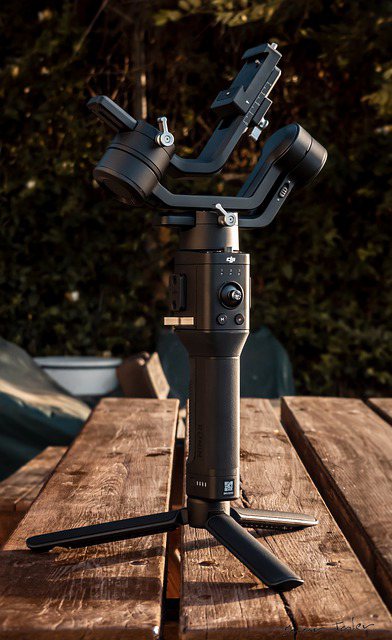
Since their launch, they have become a sizzling hot shot tool for every professional use, which is why the manufacturers started curating tons of gimbals with different versatility, performance, and budget. Let’s have a look over how to explore and embrace its in-depth abilities.
Selection– With the gimbal conquering photography, everyone out there is crazy to buy one for them. With the sudden enhancement in demand causing the major increment in supply, in easier language, the market gets a variety of gimbals with their individuality. So among that variety of gimbals, choosing one can be overwhelming. And choosing the right gimbal is the utter most essential step toward the professional shooting. There are a few points you can consider before buying a gimbal.
- Camera compatibility– Weather its compatible with your camera or not
- Axis– The number of axes the gimbal holds
- Payload– The ability to carry the maximum weight
- Power– The runtime and charging time of the gimbal
- Weight– The least weight of the gimbal’s body itself
- Portability– The ergonomic and travel-friendly factor
- Control– The wireless and control dials on the gimbal body
- Mounting– The mechanism used for connecting the camera to the gimbal
- Price– The decent pocket-friendly budget accordingly needs
- Brand– Reliably honest and market-reputation brand
Once you are done analyzing these factors, you will lead straight to your dreamy gimbal. Remember, not choosing the ideal gimbal can cause significant damage to the footage, the gimbal as well as the camera.
Balancing– Once you have your hand on the ideal gimbal, the next dominant part is balancing. Word of caution, balancing of camera or gimbal literally can decide the filming operation efficiency as well as security. So no way anyone would want to skip reading the balancing guidance of the gimbal or practicing it a bit.
There are a few things you should keep in mind while going through the whole balancing phase of the gimbal
- Mount your camera with the help of quick-release plates if possible.
- Always pre-accessorize your camera before sliding it inside the gimbal
- Check for the battery and other equipment power to avoid interrupting during the shot
- Use the Auto Calibration mode, if possible, to get the best position assigned
- Adjust the lens focusing and essential, or use the lens rigs instead
- Explore all three axes to find the right position and right balance
- Try to use the gimbal with the supportive tripod options to enhance its efficiency
- Avoid frequent interaction or detaching or attaching equipment
- Do not opt for the larger and heavier lens options from your camera
Usage– Okay, once you got the right pair of gimbals and you are done with its proper balancing, the next step is to dig into the whole process part. There are a few things you should keep in mind while engaging in gimbal usage
- Try to keep your camera really close to your subject for dramatic effect
- Don’t overdo every shot with the gimbal, and get more artistic with the shorter lens
- Always concentrate on detailing the picture with the better manual and autofocusing with the gimbal
- Always explore unusual and trickiest angles to spice the regular shooting
- The right position for carrying the gimbal is between your chest and hips
- Do not rely on the gimbal for everything; it might be a great tool, but certainly not the god
- You can always try unique things like using props that can attractively invite the audience’s eyes
- Try using an advanced tripod to let the gimbal creativity flourish at a high rate
- Do not forget to use the bokeh filter with selective focusing to add that dramatic cinema effect
- Some gimbals allow the tracking, which would be super helpful for keeping direct pace with the subject
Creative gimbals shots to slay cinematic filming
Apart from the healthy way to handle the gimbal during the shot or sneak out the secret hack to go smoothly with the gimbal shooting. There are some serious shots, or you can say move, that need to be shot using three-axis gimbals if you want to conquer the photography world.
Remember, these significant gimbal moves intend to allow as much creative vision as possible in ordinary footage; These shots can spice things up.
Parallax shot- The simplest yet creative shot where you shoot low angle by keeping a certain distance from the subject and rotating around wise with the least motion
Crane Shot- The popular shooting mode where you have to squat in a position and slowly stand up without interfering with the gimbal directions.
Freestyle Shot– The idea of leaving the gimbal move roughly or free-style without much constraint caught the best glimpse of the scenario. Cover the broadest distance with its maximum activity
Reveal Shot– Like the name suggests, frame your subject in revealing form; Use your skill to reveal your subject from any obstacle or prop’s behind.
Vertical Pivot shot– The highly creative shot where a static subject stands at the center while the gimbal moves toward the subject with little change in focusing
Motion Time-Lapse Shot– Playing with time is always fun; get creative with the time travel and let the camera capture the surroundings in a time-lapse session and engage the motion afterward.
Drone Shot- Another most creative shot where you have to fly your camera over the subject to get the artistic eyes of the drone; capturing the aerial shot like the drone perspective is responsible for a fake drone shot name.
Best Gimbal available in the market
I guess that was pretty much about gimbal’s exceptional character and competency, and if not wrong, the whole thing was much more convincing over the positive side of the tool as I have also mentioned several times that the gimbal is now becoming one of the essentials for our photography kit. This is not so only because of their quality image stabilizing but also for their creative visions and expertise.
Ultimately the gimbals are the best tool you have if you want to transform your ordinary photography. So some of the high leveled professional gimbals options you can get from the market are.
DJI RS 3 Pro 3-Axis Gimbal- With the highest ten pounds payload
Zhiyun Tech Weebill S 3 Axis Gimbal– Within Budget-friendly tag
Moza Aircross 2 3-axis Gimbal– With professional-level versatility
Wrapping up
Just a brief says the gimbals are the greatest and one of the handiest inventions in the photography world. They are designed to engage the required stability in every dynamic shot footage, much similar to the camera stabilizer and different at the same time. That much you have concluded till now.
They are a pretty affordable option that holds the power to resist movement using sharp sensors and motors. The creativity, convenience, and crafty performer Gimbals are one fitting tool for your professional shot, and you don’t need to be an expert on using one of them because of their user-friendly character. So, are you buying one for yourself?
It’s wonderful to know the details of the tool we use daily, to read about such more interesting articles, and stay connected.
Until then, Goodbye and best wishes for your photography.

